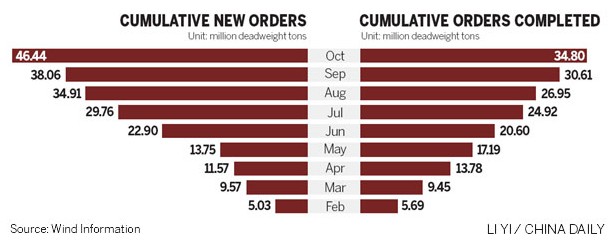Shipbuilders adrift amid troubled waters
Chinese shipbuilders will have a mixed outlook by 2020 with only one-third of them making a successful transformation and another third facing closure or mergers, experts said.
Although the global shipbuilding industry has started to pick up since the beginning of the year, many of them are still finding it difficult to escape the industrial downturn. Even those with orders in hand are struggling to make a profit, said Zhang Shengkun, president of the Shanghai Society of Naval Architects and Marine Engineers.
"I think one prediction is reliable: It says by 2020 only one-third of domestic shipbuilders will survive the industry downturn by making a successful transformation, with one-third either shutting down or merging with others, and with the remaining one-third going out," Zhang said on Monday.
"When I said 'going out', I mean two different endings. One is to develop a shipbuilding business overseas, while the other is moving into other sectors," he added.
But all the orders have been awarded to 69 shipyards, implying that the remaining 80-plus shipbuilders are without work and many of them have stopped production, Zhang said.
This complies with an earlier report that said only about 50 to 55 percent of the nation's shipbuilding capacity was used in the first three quarters of this year, down about 20 percentage points from 2012.
Bao Zhangjing, director of the China Shipbuilding Industry Research Center, estimated up to 30 percent capacity will be cut by 2015 compared with 2011.
Authorities are studying measures to encourage mergers and acquisitions within the shipbuilding industry to alleviate excess capacity while helping companies become stronger, according to the National Business Daily, citing an unnamed source.
The industrial outlook has attracted a number of leading domestic shipbuilders to shift their core business into high-end maritime engineering.
The total transaction volume of the global maritime equipment industry reached $44.5 billion in the first three quarters of this year. The whole year is expected to exceed $60 billion, the Securities Daily reported.
But Zhang said every company should make transitions according to their own backgrounds and advantages. "Maritime engineering requires technology, capital and a sophisticated industrial chain. Those lacking thorough research and investigation into their own strengths are not encouraged to leap to such a high threshold industry," he said.
"I think one prediction is reliable: It says by 2020 only one-third of domestic shipbuilders will survive the industry downturn by making a successful transformation, with one-third either shutting down or merging with others, and with the remaining one-third going out," Zhang said on Monday.
"When I said 'going out', I mean two different endings. One is to develop a shipbuilding business overseas, while the other is moving into other sectors," he added.

But all the orders have been awarded to 69 shipyards, implying that the remaining 80-plus shipbuilders are without work and many of them have stopped production, Zhang said.
This complies with an earlier report that said only about 50 to 55 percent of the nation's shipbuilding capacity was used in the first three quarters of this year, down about 20 percentage points from 2012.
Bao Zhangjing, director of the China Shipbuilding Industry Research Center, estimated up to 30 percent capacity will be cut by 2015 compared with 2011.
Authorities are studying measures to encourage mergers and acquisitions within the shipbuilding industry to alleviate excess capacity while helping companies become stronger, according to the National Business Daily, citing an unnamed source.
The industrial outlook has attracted a number of leading domestic shipbuilders to shift their core business into high-end maritime engineering.
The total transaction volume of the global maritime equipment industry reached $44.5 billion in the first three quarters of this year. The whole year is expected to exceed $60 billion, the Securities Daily reported.
But Zhang said every company should make transitions according to their own backgrounds and advantages. "Maritime engineering requires technology, capital and a sophisticated industrial chain. Those lacking thorough research and investigation into their own strengths are not encouraged to leap to such a high threshold industry," he said.








